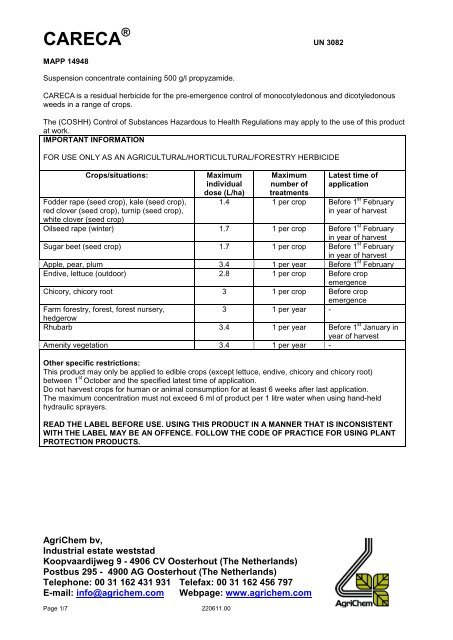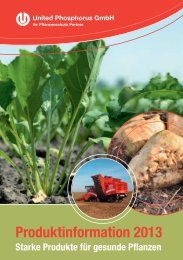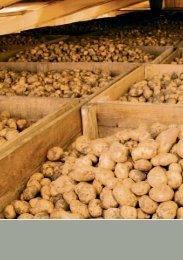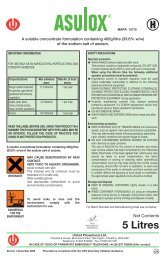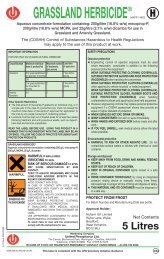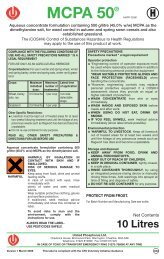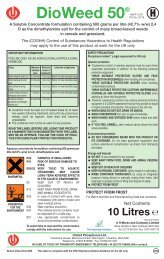CARECA
CARECA
CARECA
You also want an ePaper? Increase the reach of your titles
YUMPU automatically turns print PDFs into web optimized ePapers that Google loves.
<strong>CARECA</strong> ®<br />
MAPP 14948<br />
Suspension concentrate containing 500 g/l propyzamide.<br />
AgriChem bv,<br />
Industrial estate weststad<br />
Koopvaardijweg 9 - 4906 CV Oosterhout (The Netherlands)<br />
Postbus 295 - 4900 AG Oosterhout (The Netherlands)<br />
Telephone: 00 31 162 431 931 Telefax: 00 31 162 456 797<br />
E-mail: info@agrichem.com Webpage: www.agrichem.com<br />
Page 1/7 220611.00<br />
UN 3082<br />
<strong>CARECA</strong> is a residual herbicide for the pre-emergence control of monocotyledonous and dicotyledonous<br />
weeds in a range of crops.<br />
The (COSHH) Control of Substances Hazardous to Health Regulations may apply to the use of this product<br />
at work.<br />
IMPORTANT INFORMATION<br />
FOR USE ONLY AS AN AGRICULTURAL/HORTICULTURAL/FORESTRY HERBICIDE<br />
Crops/situations: Maximum<br />
individual<br />
Fodder rape (seed crop), kale (seed crop),<br />
red clover (seed crop), turnip (seed crop),<br />
white clover (seed crop)<br />
dose (L/ha)<br />
Maximum<br />
number of<br />
treatments<br />
Latest time of<br />
application<br />
1.4 1 per crop Before 1 st February<br />
in year of harvest<br />
Oilseed rape (winter) 1.7 1 per crop Before 1 st February<br />
in year of harvest<br />
Sugar beet (seed crop) 1.7 1 per crop Before 1 st February<br />
in year of harvest<br />
Apple, pear, plum 3.4 1 per year Before 1 st February<br />
Endive, lettuce (outdoor) 2.8 1 per crop Before crop<br />
emergence<br />
Chicory, chicory root 3 1 per crop Before crop<br />
emergence<br />
Farm forestry, forest, forest nursery,<br />
3 1 per year -<br />
hedgerow<br />
Rhubarb 3.4 1 per year Before 1 st January in<br />
year of harvest<br />
Amenity vegetation 3.4 1 per year -<br />
Other specific restrictions:<br />
This product may only be applied to edible crops (except lettuce, endive, chicory and chicory root)<br />
between 1 st October and the specified latest time of application.<br />
Do not harvest crops for human or animal consumption for at least 6 weeks after last application.<br />
The maximum concentration must not exceed 6 ml of product per 1 litre water when using hand-held<br />
hydraulic sprayers.<br />
READ THE LABEL BEFORE USE. USING THIS PRODUCT IN A MANNER THAT IS INCONSISTENT<br />
WITH THE LABEL MAY BE AN OFFENCE. FOLLOW THE CODE OF PRACTICE FOR USING PLANT<br />
PROTECTION PRODUCTS.
<strong>CARECA</strong> ®<br />
MAPP 14948<br />
LIMITED EVIDENCE OF A CARCINOGENIC EFFECT. (R40)<br />
TOXIC TO AQUATIC ORGANISMS, MAY CAUSE LONG-TERM<br />
ADVERSE EFFECTS IN THE AQUATIC ENVIRONMENT. (R51/53)<br />
KEEP OUT OF REACH OF CHILDREN. (S2)<br />
KEEP AWAY FROM FOOD, DRINK AND ANIMAL FEEDING STUFFS. (S13)<br />
WHEN USING DO NOT EAT, DRINK OR SMOKE. (S20/21)<br />
WEAR SUITABLE PROTECTIVE CLOTHING AND GLOVES. (S36/37)<br />
USE APPROPRIATE CONTAINMENT TO AVOID ENVIRONMENTAL<br />
CONTAMINATION. (S57)<br />
DO NOT CONTAMINATE WATER WITH THE PRODUCT OR ITS CONTAINER.<br />
DO NOT CLEAN APPLICATION EQUIPMENT NEAR SURFACE WATER. AVOID<br />
CONTAMINATION VIA DRAINS FROM FARMYARDS AND ROADS. (SP1)<br />
AgriChem bv,<br />
Industrial estate weststad<br />
Koopvaardijweg 9 - 4906 CV Oosterhout (The Netherlands)<br />
Postbus 295 - 4900 AG Oosterhout (The Netherlands)<br />
Telephone: 00 31 162 431 931 Telefax: 00 31 162 456 797<br />
E-mail: info@agrichem.com Webpage: www.agrichem.com<br />
Page 2/7 220611.00<br />
UN 3082<br />
To avoid risks to man and the environment, comply with the instructions for use.<br />
SAFETY PRECAUTIONS<br />
Operator Protection<br />
WHEN USING DO NOT EAT, DRINK OR SMOKE.<br />
WASH HANDS before eating and drinking and after work.<br />
Engineering control of operator exposure must be used where reasonably practicable in addition to the<br />
following personal protective equipment:<br />
OPERATORS MUST WEAR SUITABLE PROTECTIVE GLOVES when handling the concentrate or<br />
handling contaminated surfaces.<br />
OPERATORS MUST WEAR SUITABLE PROTECTIVE CLOTHING (coveralls) and suitable protective<br />
gloves when applying by hand-held equipment.<br />
However, engineering controls may replace personal protective equipment where a COSHH assessment<br />
shows they provide an equal or higher standard of protection.<br />
Environmental protection<br />
DO NOT CONTAMINATE WATER with the product or its container. Do not clean application equipment near<br />
surface water. Avoid contamination via drains from farmyards and roads.<br />
USE APPROPRIATE CONTAINMENT to avoid environmental contamination.<br />
EXTREME CARE must be taken to avoid spray drift on to non-crop plants outside of the target area.<br />
Consumer protection<br />
DO NOT HARVEST FOR HUMAN OR ANIMAL CONSUMPTION for at least 6 weeks after last application.<br />
Storage and disposal<br />
PROTECT FROM FROST.<br />
KEEP IN ORIGINAL CONTAINER, tightly closed, in a safe place.<br />
EMPTY CONTAINER COMPLETELY and dispose of safely.<br />
THIS MATERIAL (AND ITS CONTAINER) must be disposed of in a safe way.<br />
Medical advice<br />
IF YOU FEEL UNWELL, seek medical advice immediately (show the label where possible).<br />
HARMFUL<br />
DANGEROUS<br />
FOR THE<br />
ENVIRONMENT<br />
DIRECTIONS FOR USE<br />
IMPORTANT: This information is approved as part of the Product Label. All instructions within this section<br />
must be read carefully in order to obtain safe and successful use of this product.
<strong>CARECA</strong> ®<br />
MAPP 14948<br />
AgriChem bv,<br />
Industrial estate weststad<br />
Koopvaardijweg 9 - 4906 CV Oosterhout (The Netherlands)<br />
Postbus 295 - 4900 AG Oosterhout (The Netherlands)<br />
Telephone: 00 31 162 431 931 Telefax: 00 31 162 456 797<br />
E-mail: info@agrichem.com Webpage: www.agrichem.com<br />
Page 3/7 220611.00<br />
UN 3082<br />
<strong>CARECA</strong> is a residual herbicide for the pre-emergence control of monocotyledonous weeds and<br />
dicotyledonous weeds in a wide range of crops. This herbicide stops plant growth by inhibiting cell division in<br />
shoots and roots. Uptake occurs through the roots and the action sites are the meristem cells in roots and<br />
shoots.<br />
For best results ensure an even soil coverage when weeds have not yet emerged. The best results are<br />
achieved by winter application to bare fine, firm and moist soil. Rain is required after application if the soil is<br />
dry. The uptake of the product by weeds is slow. Excessive organic debris, straw, ask or ploughed-up turf<br />
may reduce the effectiveness of the product. <strong>CARECA</strong> can be applied in frosty conditions, but should not be<br />
applied where the soil is frozen and run-off is likely to occur.<br />
RESTRICTIONS<br />
Maximum number of treatments is 1 per crop or 1 per year. Maximum total application rate is therefore<br />
equivalent to one full application rate for all crops.<br />
Take care to avoid local overdosing.<br />
Do not make more than one application of <strong>CARECA</strong> within 9 months of the same area of land.<br />
Do not treat protected crops.<br />
Do not spray in windy weather and avoid drift onto neighboring crops, or non-target plants.<br />
No taints have been detected in tests with treated field crops. Consult processor before using on crops being<br />
grown for processing.<br />
Treated clover, fodder rape, kale, turnip and sugarbeet must not be used for human or animal consumption.<br />
<strong>CARECA</strong> can be used on all soil types with the following exception: do not use on soils containing more than<br />
10% organic matter except in forestry.<br />
Resistance warning<br />
Propyzamide is in the chemical family of Benzamides which inhibit the assembly of microtubules.<br />
It is recommended not to overuse products based on such modes of action on the same field.<br />
Strains of some annual grasses (e.g. blackgrass, wild oats, Italian ryegrass) have developed resistance to<br />
herbicides which may lead to poor control. A strategy for preventing and managing such resistance should<br />
be adopted. Guidelines have been produced by the Weed Resistance Action Group and copies are available<br />
from the HGCA, CPA, your distributor, crop adviser or product manufacturer.<br />
Certain weeds may develop resistance to products of AgriChem B.V. Since such circumstances are beyond<br />
our control, AgriChem B.V. will not be under liability for any resulting loss or damage whatsoever.<br />
WEED CONTROL AND CROP SPECIFIC INFORMATION<br />
AGRICULTURAL CROPS<br />
When applied to winter oilseed rape, chicory, chicory root or seed crops of any of the following: red or white<br />
clover, fodder rape, kale, turnip or sugar beet, the susceptibilities of common weed species to <strong>CARECA</strong> at<br />
1.4 litres/ha (applied pre-emergence) are given below: (Note: Please refer to section on sugar beet for their<br />
recommended rates of use).
<strong>CARECA</strong> ®<br />
MAPP 14948<br />
Annual Meadow-grass S<br />
Barren Brome S<br />
Black-bindweed S<br />
Black grass S<br />
Cleavers MS<br />
S: Susceptible<br />
MS: Moderately susceptible.<br />
Chickweed, Common S<br />
Fat-hen S<br />
Forget-me-not, field MS<br />
Knotgrass S<br />
Nettle, Small S<br />
AgriChem bv,<br />
Industrial estate weststad<br />
Koopvaardijweg 9 - 4906 CV Oosterhout (The Netherlands)<br />
Postbus 295 - 4900 AG Oosterhout (The Netherlands)<br />
Telephone: 00 31 162 431 931 Telefax: 00 31 162 456 797<br />
E-mail: info@agrichem.com Webpage: www.agrichem.com<br />
Page 4/7 220611.00<br />
UN 3082<br />
Note - On clover application must only be made to crops grown for 'at least' one season.<br />
Nightshade, Black S<br />
Redshank S<br />
Speedwells S<br />
Volunteer Cereals S<br />
Wild oat S<br />
Winter oilseed rape<br />
<strong>CARECA</strong> may be applied as soon as possible after the crop has reached the 3 rd true leaf stage, between 1 st<br />
October and 31 st January.<br />
Crop selectivity is by depth protection. Factors which cause shallow rooting may reduce crop safety.<br />
Application rate: 1.4 - 1.7 litres/ha.<br />
Chicory and chicory root<br />
<strong>CARECA</strong> may be applied shortly after drilling and before crop emergence.<br />
Application rate: 3 litres/ha.<br />
Seed crops of sugar beet<br />
<strong>CARECA</strong> may be applied as soon as possible after the crop has reached the 4 th true leaf stage, between 1 st<br />
October and 31 st January.<br />
Application rate: 1.7 litres/ha.<br />
Seed crops of fodder rape, kale or turnip<br />
<strong>CARECA</strong> may be applied as soon as possible after the crop has reached the 3 rd true leaf stage, between 1 st<br />
October and 31 st January.<br />
Application rate: 1.4 litres/ha.<br />
Seed crops of red or white clover<br />
<strong>CARECA</strong> should only be applied to established crops grown for at least one season, between 1 st October<br />
and 31 st January.<br />
Application rate: 1.4 litres/ha.<br />
HORTICULTURAL CROPS<br />
When applied to apple, pear, plum or rhubarb the susceptibilities of common weed species to <strong>CARECA</strong> at<br />
1.7 litres/ha (applied pre-emergence) are given below:<br />
Annual Meadow-grass S<br />
Barren Brome S<br />
Black-bindweed S<br />
Black grass S<br />
Chickweed, Common<br />
S: Susceptible<br />
S<br />
Fat-hen S<br />
Knotgrass S<br />
Nettle, Small S<br />
Nightshade, Black S<br />
Redshank S<br />
Speedwells S<br />
Volunteer Cereals S<br />
Wild oat S
<strong>CARECA</strong> ®<br />
MAPP 14948<br />
AgriChem bv,<br />
Industrial estate weststad<br />
Koopvaardijweg 9 - 4906 CV Oosterhout (The Netherlands)<br />
Postbus 295 - 4900 AG Oosterhout (The Netherlands)<br />
Telephone: 00 31 162 431 931 Telefax: 00 31 162 456 797<br />
E-mail: info@agrichem.com Webpage: www.agrichem.com<br />
Page 5/7 220611.00<br />
UN 3082<br />
Where the higher rate of 2.8 - 3.4 litres/ha (applied pre-emergence) is used, the following weeds may also<br />
be controlled:<br />
Broad-leaved Dock S<br />
Cleavers S<br />
Common Fumitory MS<br />
S: Susceptible<br />
MS: Moderately susceptible.<br />
Creeping Buttercup S<br />
Field Horsetail MS<br />
Sheep's Sorrel S<br />
Shepherd's-purse MS<br />
Apple, pear and plum<br />
<strong>CARECA</strong> may be applied to established crops grown for at least one season, between 1 st October and 31 st<br />
January.<br />
Application rate:<br />
Annual Weeds 1.7 litres/ha.<br />
Perennial and Annual Weeds 3.4 litres/ha.<br />
Rhubarb<br />
<strong>CARECA</strong> may be applied to established crops grown for at least one season, between 1 st October and 31 st<br />
December.<br />
Application rate:<br />
Annual Weeds 1.7 litres/ha.<br />
Perennial and Annual Weeds 3.4 litres/ha.<br />
Endive and lettuce (outdoor crops only)<br />
<strong>CARECA</strong> may be applied shortly after drilling and before crop emergence or shortly before planting.<br />
Application rate: 2.2 - 2.8 litres/ha.<br />
Use the higher rate under dry soil conditions or warm weather, and irrigate or incorporate.<br />
When used at these rates on lettuce, the susceptibilities of common weed species to <strong>CARECA</strong> are given<br />
below:<br />
Annual Meadow-grass S<br />
Barren Brome S<br />
Black-bindweed S<br />
Black grass S<br />
Cleavers MS<br />
Chickweed, Common S<br />
S: Susceptible<br />
MS: Moderately susceptible.<br />
Common Fumitory MS<br />
Fat-hen S<br />
Knotgrass S<br />
Nettle, Small S<br />
Nightshade, Black S<br />
Redshank S<br />
Shepherd's-purse MS<br />
Speedwells S<br />
Volunteer Cereals S<br />
Wild oat S<br />
FORESTRY, FARM FORESTRY, FOREST NURSERY, HEDGEROW.<br />
<strong>CARECA</strong> is recommended for use on the following species:<br />
Alder, beech, southern beech, birch, douglas fir, grand fir, noble fir, horse chestnut, larch, lawson cypress,<br />
oak, bishop pine, corsican pine, lodgepole pine, monterey pine, scots pine, poplar, norway spruce,<br />
sycamore, sitka spruce, western hemlock and wild cherry.<br />
<strong>CARECA</strong> should be applied:<br />
- between 1 st October and 31 st January North of a line from Aberystwyth to London and on the following<br />
soil types: Mineral Soils (surface water gleys, brown earths and sands),<br />
- between 1st October and 31st December South of a line from Aberystwyth to London and on the<br />
following soil types: Peat Soils (peaty gleys and peat soils with a depth of organic matter greater than<br />
10 cm).
<strong>CARECA</strong> ®<br />
MAPP 14948<br />
AgriChem bv,<br />
Industrial estate weststad<br />
Koopvaardijweg 9 - 4906 CV Oosterhout (The Netherlands)<br />
Postbus 295 - 4900 AG Oosterhout (The Netherlands)<br />
Telephone: 00 31 162 431 931 Telefax: 00 31 162 456 797<br />
E-mail: info@agrichem.com Webpage: www.agrichem.com<br />
Page 6/7 220611.00<br />
UN 3082<br />
Application rate: 3 litres/ha (applied pre-emergence of the weeds).<br />
Note: For nurseries treat no earlier than one month after transplanting. For forests treat at any stage<br />
including pre-planting.<br />
When used at this rate the susceptibilities of common weed species to <strong>CARECA</strong> are given below:<br />
Cook’s foot S<br />
Common Bent S<br />
Common couch S<br />
Creeping soft grass S<br />
S: Susceptible<br />
MS: Moderately susceptible.<br />
R: Resistant<br />
Field horsetail MS<br />
Foxglove R<br />
Other perennial grasses S<br />
Sedges MS<br />
Sweet vernal grass S<br />
Tufted hair-grass S<br />
Willowherbs R<br />
Yorkshire fog S<br />
AMENITY VEGETATION<br />
<strong>CARECA</strong> is recommended for use on the following species which have been planted out not later than the<br />
previous spring: Berberis darwinii, Buddleia davidii, Chamaecyparis spp (False Cypress), Cotoneaster spp,<br />
Crataegus spp (Hawthorns), Fagus sylvatica (Beech), Forsythia x intermedia, Ilex aquifolium (Holly), Larix<br />
decidua (Larch), Philadelphus spp (Mock Orange), Picea spp (Spruces), Pinus spp (Pines), Prunus<br />
gladulosa, Quercus spp (Oak), Rosa spp (Roses including Rose rootstocks), Spiraea x bumalda 'Froebelii',<br />
Syringa vulgaris (Lilac), Taxus baccata (Yew), Thuja orientalis, 'Rosedalis'.<br />
<strong>CARECA</strong> should be applied on established crops grown for at least one season, between 1 st October and<br />
31 st January.<br />
Application rate: 1.7 - 3.4 litres/ha (applied pre-emergence of the weeds).<br />
At the 1.7 litres/ha rate the susceptibilities of common weed species to <strong>CARECA</strong> are given below:<br />
Annual meadow grass S<br />
Barren brome S<br />
Blackgrass S<br />
Common chickweed S<br />
S: Susceptible<br />
MR: Moderately resistant.<br />
Black Bindweed MR<br />
Black nightshade MR<br />
Fat-hen S<br />
Knotgrass S<br />
Redshank S<br />
Small Nettle S<br />
Volunteer cereals S<br />
Wild-oat S<br />
When the higher application rate of 3.4 litres/ha (applied pre-emergence) is used, the following weeds may<br />
also be controlled:<br />
Broad leaved dock S<br />
Common couch S<br />
Common fumitory MS<br />
S: Susceptible<br />
MS: Moderately susceptible.<br />
Creeping buttercup S<br />
Cleavers S<br />
Field horsetail MS<br />
Other perennial grasses S<br />
Sheep's sorrel S<br />
Shepherd's purse MS<br />
ALL LISTED CROPS<br />
For all rates at any time of the year and at any stage of the crop the following will apply:<br />
Common poppy R Scarlet pimpernel R Ragwort R<br />
Gallant soldier R Clover R Thistle R<br />
Groundsel R Dandelion R<br />
Mayweed<br />
R: Resistant<br />
R Field bindweed R
<strong>CARECA</strong> ®<br />
MAPP 14948<br />
AgriChem bv,<br />
Industrial estate weststad<br />
Koopvaardijweg 9 - 4906 CV Oosterhout (The Netherlands)<br />
Postbus 295 - 4900 AG Oosterhout (The Netherlands)<br />
Telephone: 00 31 162 431 931 Telefax: 00 31 162 456 797<br />
E-mail: info@agrichem.com Webpage: www.agrichem.com<br />
Page 7/7 220611.00<br />
UN 3082<br />
FOLLOWING CROPS<br />
The time between application of <strong>CARECA</strong> and planting or sowing succeeding crops is given in the table<br />
below.<br />
Following crop Date propyzamide applied to previous crop<br />
Between 1 April – 31 Between 1 August – 31<br />
July<br />
March<br />
Lettuce 0 weeks 0 weeks<br />
Field beans, broad beans, peas, chicory, radish,<br />
clover, lucerne<br />
5 weeks 10 weeks<br />
Brassicas, leeks, onions, parsley, parsnips,<br />
10 weeks 25 weeks or after 15 June,<br />
celery, oilseed rape, strawberries<br />
whichever comes first<br />
Cereals, grasses¹ 40 weeks 40 weeks for application<br />
rates up to 3.4 litres/ha;<br />
30 weeks for application<br />
rates below 1.7 litres/ha<br />
Any other crop¹ 20 weeks 40 weeks<br />
1<br />
Treated land must be mould board ploughed to a depth of 15 cm prior to drilling a following cereal,<br />
grass, or any other crops not listed above.<br />
MIXING AND SPRAYING<br />
For agricultural crops, apply as a mechanical spray to the soil in 200 – 1000 litres water per hectare as a<br />
MEDIUM quality spray (BCPC classification).<br />
For horticultural crops, forestry and amenity vegetation, apply in 400 – 1000 litres water per hectare as a<br />
MEDIUM quality spray (BCPC classification).<br />
In forestry and amenity vegetation, a knapsack sprayer can also be used. Apply 300-1000 litres per hectare<br />
as MEDIUM quality spray (BCPC classification).<br />
Check and clean all hoses, nozzles and equipment to be used prior to use. Half fill the sprayer tank with<br />
clean water and begin agitation. Add the required quantity of <strong>CARECA</strong>. Fill the spray tank with water as<br />
required whilst agitating. Continue agitating during spraying.<br />
Spray immediately, so do not allow the mixture to stand.<br />
Wash sprayer thoroughly with wetting agent and water immediately after spraying. Wash out with water.<br />
CONDITIONS OF SUPPLY<br />
All goods supplied by us are of high grade and suitable for use. Since we cannot control the conditions of<br />
storage, handling or use or the weather conditions before or after application, which may affect the<br />
performance of the goods, all conditions and warranties, statutory or otherwise, as to the quality of fitness of<br />
our goods are excluded. We cannot therefore accept any responsibility for any failure in performance,<br />
damage or injury whatsoever, arising from storage, handling, application or use.<br />
SHAKE WELL BEFORE USE.


